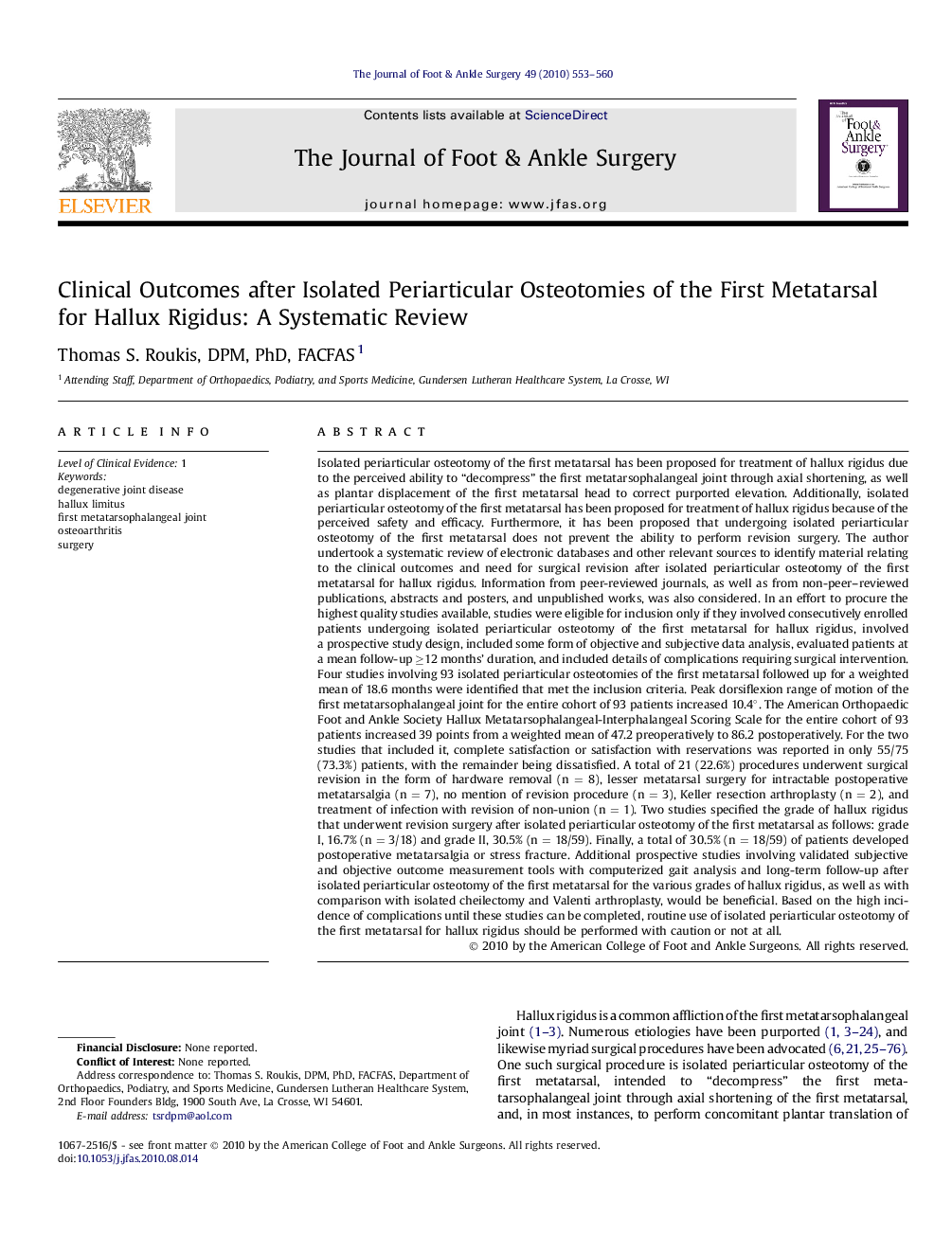| کد مقاله | کد نشریه | سال انتشار | مقاله انگلیسی | نسخه تمام متن |
|---|---|---|---|---|
| 2722824 | 1565556 | 2010 | 8 صفحه PDF | دانلود رایگان |

Isolated periarticular osteotomy of the first metatarsal has been proposed for treatment of hallux rigidus due to the perceived ability to “decompress” the first metatarsophalangeal joint through axial shortening, as well as plantar displacement of the first metatarsal head to correct purported elevation. Additionally, isolated periarticular osteotomy of the first metatarsal has been proposed for treatment of hallux rigidus because of the perceived safety and efficacy. Furthermore, it has been proposed that undergoing isolated periarticular osteotomy of the first metatarsal does not prevent the ability to perform revision surgery. The author undertook a systematic review of electronic databases and other relevant sources to identify material relating to the clinical outcomes and need for surgical revision after isolated periarticular osteotomy of the first metatarsal for hallux rigidus. Information from peer-reviewed journals, as well as from non-peer–reviewed publications, abstracts and posters, and unpublished works, was also considered. In an effort to procure the highest quality studies available, studies were eligible for inclusion only if they involved consecutively enrolled patients undergoing isolated periarticular osteotomy of the first metatarsal for hallux rigidus, involved a prospective study design, included some form of objective and subjective data analysis, evaluated patients at a mean follow-up ≥12 months’ duration, and included details of complications requiring surgical intervention. Four studies involving 93 isolated periarticular osteotomies of the first metatarsal followed up for a weighted mean of 18.6 months were identified that met the inclusion criteria. Peak dorsiflexion range of motion of the first metatarsophalangeal joint for the entire cohort of 93 patients increased 10.4°. The American Orthopaedic Foot and Ankle Society Hallux Metatarsophalangeal-Interphalangeal Scoring Scale for the entire cohort of 93 patients increased 39 points from a weighted mean of 47.2 preoperatively to 86.2 postoperatively. For the two studies that included it, complete satisfaction or satisfaction with reservations was reported in only 55/75 (73.3%) patients, with the remainder being dissatisfied. A total of 21 (22.6%) procedures underwent surgical revision in the form of hardware removal (n = 8), lesser metatarsal surgery for intractable postoperative metatarsalgia (n = 7), no mention of revision procedure (n = 3), Keller resection arthroplasty (n = 2), and treatment of infection with revision of non-union (n = 1). Two studies specified the grade of hallux rigidus that underwent revision surgery after isolated periarticular osteotomy of the first metatarsal as follows: grade I, 16.7% (n = 3/18) and grade II, 30.5% (n = 18/59). Finally, a total of 30.5% (n = 18/59) of patients developed postoperative metatarsalgia or stress fracture. Additional prospective studies involving validated subjective and objective outcome measurement tools with computerized gait analysis and long-term follow-up after isolated periarticular osteotomy of the first metatarsal for the various grades of hallux rigidus, as well as with comparison with isolated cheilectomy and Valenti arthroplasty, would be beneficial. Based on the high incidence of complications until these studies can be completed, routine use of isolated periarticular osteotomy of the first metatarsal for hallux rigidus should be performed with caution or not at all.
Journal: The Journal of Foot and Ankle Surgery - Volume 49, Issue 6, November–December 2010, Pages 553–560